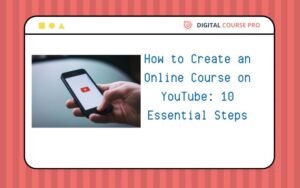Pay-Per-Click (PPC) Advertising: Driving Traffic and Conversions is a crucial module within the “10 Steps to Mastering Simply Passive Digital Marketing Course.” This segment explores the fundamentals and advanced strategies necessary to leverage PPC campaigns effectively. Whether you’re new to digital advertising or aiming to refine your PPC tactics, this course offers a comprehensive guide to maximizing your ROI through targeted campaigns. Learn how to create compelling ads, optimize bidding strategies, and analyze performance metrics to drive traffic and achieve conversions. Dive into our detailed page to start mastering PPC advertising and enhance your digital marketing strategy today.
Understanding PPC Basics
- How PPC Works:
PPC (Pay-Per-Click) advertising is a model where advertisers pay a fee each time their ad is clicked. It allows businesses to bid for ad placement in a search engine’s sponsored links when someone searches for a keyword related to their business offerings. - PPC Platforms:
- Google Ads: The largest PPC platform, displaying ads on Google’s search engine and its advertising network.
- Bing Ads (Microsoft Advertising): Displays ads on Bing search engine and Yahoo networks, reaching a different audience than Google.
- Key Terminology:
- Keywords: Words or phrases that trigger your ads when users search for them.
- Ad Rank: Determines ad position based on bid amount, ad quality (relevance, expected CTR), and landing page experience.
- Quality Score: Google Ads metric that measures ad relevance, CTR, and landing page quality, influencing ad position and cost-per-click (CPC).
Setting Campaign Objectives and Goals
- Defining Objectives:
- Increasing Website Traffic: Drive more visitors to your website to increase brand visibility and engagement.
- Generating Leads: Capture contact information from potential customers interested in your products or services.
- Boosting Sales: Drive conversions and revenue directly through PPC campaigns.
- SMART Goals:
- Specific: Clearly define what you want to achieve with your PPC campaigns.
- Measurable: Use metrics like clicks, conversions, and ROI to track progress.
- Achievable: Ensure goals are realistic within your budget and resources.
- Relevant: Align with overall business objectives and marketing strategy.
- Time-bound: Set deadlines for achieving your PPC goals to measure success.
Keyword Research and Selection
- Effective Strategies:
- Keyword Planner Tools: Use tools like Google Keyword Planner, SEMrush, and Ahrefs to discover relevant keywords, search volumes, and competition levels.
- Long-Tail Keywords: Target specific, less competitive phrases that indicate higher purchase intent and conversion rates.
- Negative Keywords: Exclude irrelevant terms to prevent wasted ad spend and improve ad targeting.
- Organizing Keywords:
- Ad Groups: Group related keywords into ad groups based on themes or products/services to create targeted ad campaigns.
- Campaign Structure: Organize campaigns hierarchically by themes or product categories to manage budgets and performance effectively.
Creating Compelling Ad Copy
- Writing Persuasive Ad Copy:
- Headlines: Craft attention-grabbing headlines that include keywords and highlight unique selling propositions (USPs).
- Description: Clearly communicate benefits, offers, and calls-to-action (CTAs) to encourage clicks.
- Ad Extensions: Enhance ads with additional information like site links, callouts, and structured snippets to improve visibility and relevance.
Ad Extensions and Formats
- Types of Ad Extensions:
- Sitelink Extensions: Direct users to specific pages on your website.
- Callout Extensions: Highlight key features, benefits, or offers.
- Structured Snippets: Showcase specific aspects of your products or services.
- Call Extensions: Display phone numbers with your ads for direct calls from potential customers.
- Ad Formats:
- Text Ads: Standard PPC ads with headlines, descriptions, and display URLs.
- Display Ads: Visual ads with images or rich media displayed on websites within the Google Display Network.
- Shopping Ads: Product-specific ads that display images, prices, and retailer names in search results, ideal for e-commerce businesses.
Setting Up Landing Pages
- Optimized Landing Pages:
- Relevance: Ensure landing pages align with ad copy and keywords to provide a cohesive user experience.
- Clear Call-to-Action (CTA): Guide visitors toward desired actions such as making a purchase or filling out a contact form.
- Mobile Optimization: Design responsive landing pages that load quickly and function well on mobile devices to enhance user experience and conversions.
Bidding Strategies and Budget Management
- Bidding Strategies:
- Manual CPC (Cost-Per-Click): Set maximum CPC bids for each keyword manually to control costs and maximize visibility.
- Automated Bidding: Use Google’s automated bidding strategies like Target CPA (Cost-Per-Acquisition) or Target ROAS (Return on Ad Spend) to optimize bids based on conversion goals.
- Budget Allocation:
- Daily Budget: Set limits on daily ad spend to manage costs and prevent overspending.
- Bid Adjustments: Adjust bids based on device type, location, time of day, or audience segments to optimize campaign performance.
Monitoring and Optimization
- Analytics Tools:
- Google Analytics: Track website traffic, conversions, and user behavior from PPC campaigns.
- Google Ads Performance Dashboard: Monitor key metrics such as CTR, conversion rate, and quality score to evaluate campaign effectiveness.
- Optimization Techniques:
- Keyword Performance: Identify high-performing keywords and adjust bids or ad copy to capitalize on opportunities.
- Ad Testing: Conduct A/B tests to compare different ad variations and determine which elements (headlines, CTAs, visuals) drive better results.
- Landing Page Optimization: Test landing page elements (CTAs, forms, layout) to improve conversion rates and user experience.
A/B Testing and Experimentation
- Testing Variables:
- Ad Copy: Compare different headlines, descriptions, or calls-to-action to identify which variations perform best.
- Landing Pages: Test variations of landing page layouts, content, and forms to optimize conversion rates.
- Targeting Options: Experiment with audience targeting parameters to reach the most responsive segments effectively.
- Iterative Improvements:
- Continuous Testing: Regularly test and refine PPC campaigns based on data-driven insights and performance metrics.
- Scaling Success: Scale successful ad variations, keywords, and strategies to increase campaign effectiveness and ROI over time.
By mastering these elements of PPC advertising, businesses can drive targeted traffic, generate leads, and achieve measurable results through strategic campaign planning, optimization, and continuous improvement.





